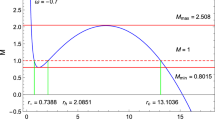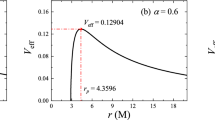Abstract
We demonstrate that a dark silhouette of the black hole illuminated by a thin accretion disk and seen by a distant observer is, in fact, a silhouette of the event horizon hemisphere. The boundary of this silhouette is a contour of the event horizon equatorial circle if a thin accretion disk is placed in the black hole equatorial plane. A luminous matter plunging into black hole from different directions provides the observational opportunity for recovering a total silhouette of the invisible event horizon globe. The event horizon silhouette is projected on the celestial sphere within a position of the black hole shadow. A relative position of the bright part of the accretion disk with respect to the position of event horizon silhouette in the presented first image the black hole in the galaxy M87 corresponds to a rather high value of the black hole spin, \(a\simeq 0.75\).












Similar content being viewed by others
References
Gillessen, S., Eisenhauer, F., Trippe, S., Alexander, T., Genzel, R., Martins, F., Ott, T.: Monitoring stellar orbits around the massive black hole in the Galactic Center. Astrophys. J. 692, 1075–1109 (2009)
Meyer, L., Ghez, A.M., Schodel, R., Yelda, S., Boehle, A., Lu, J.R., Do, T., Morris, M.R., Becklin, E.E., Matthews, K.: The shortest known period star orbiting our Galaxy’s supermassive black hole. Science 338, 84–87 (2012)
Johnson, M.D., et al.: Resolved magnetic-field structure and variability near the event horizon of Sagittarius A*. Science 350, 1242 (2015)
Chatzopoulos, S., Fritz, T.K., Gerhard, O., Gillessen, S., Wegg, C., Genzel, R., Pfuhl, O.: The old nuclear star cluster in the Milky Way: dynamics, mass, statistical parallax, and black hole mass. Mon. Not. R. Astron. Soc. 447, 948 (2015)
Dokuchaev, V.I., Eroshenko, YuN: Physical laboratory at the center of the Galaxy. Physics-Uspekhi 58, 772–784. arXiv:1512.02943 [astro-ph.HE] (2015)
Johannsen, T.: Sgr A* and General Relativity. Class. Quantum Grav. 33, 113001 (2016)
Eckart, A., Huttemann, A., Kiefer, C., Britzen, S., Zajacek, M., Lammerzahl, C., Stockler, M., Valencia-S, M., Karas, V., García-Marín, M.: The Milky Way’s supermassive black hole: how good a case is it? A challenge for astrophysics and philosophy of science. Found. Phys. 47, 553 (2017)
Zhu, Z., Johnson, M.D., Narayan, R.: Testing General Relativity with the black hole shadow size and asymmetry of Sagittarius A*: limitations from interstellar scattering. Astrophys. J. 870, 6 (2019)
Zakharov, A.F.: Tests of gravity theories with Galactic Center observations. Int. J. Mod. Phys. D (2019). https://doi.org/10.1142/S0218271819410037
Tuan Do et al.: Envisioning the next decade of Galactic Center science: a laboratory for the study of the physics and astrophysics of supermassive black holes. arXiv:1903.05293 [astro-ph.GA]
Fish, V., Akiyama, K., Bouman, K., Chael, A., Johnson, M., Doeleman, S., Blackburn, L., Wardle, John, Freeman, W., The Event Horizon Telescope Collaboration: Observing—and imaging—Active Galactic Nuclei with the Event Horizon Telescope. Galaxies 4, 54 (2016)
Lacroix, T., Silk, J.: Constraining the distribution of dark matter at the Galactic centre using the high-resolution Event Horizon Telescope. Astron. Astrophys. 554, A36 (2013)
Kamruddin, A.B., Dexter, J.: A geometric crescent model for black hole images. Mon. Not. R. Astron. Soc. 434, 765–771 (2013)
Johannsen, T., Wang, C., Broderick, A.E., Doeleman, S.S., Fish, V.L., Loeb, A., Psaltis, D.: Testing General Relativity with accretion-flow imaging of Sgr A*. Phys. Rev. Lett. 116, 031101 (2016)
Johannsen, T., Wang, C., Broderick, A.E., Doeleman, S.S., Fish, V.L., Loeb, A., Psaltis, D.: Testing General Relativity with accretion-flow imaging of Sgr A*. Phys. Rev. Lett. 117, 091101 (2016)
Broderick, A.E., Fish, V.L., Johnson, M.D., Rosenfeld, K., Wang, C., Doeleman, S.S., Akiyama, K., Johannsen, T., Roy, A.L.: Modeling seven years of Event Horizon Telescope observations with radiatively inefficient accretion flow models. Astrophys. J. 820, 137 (2016)
Kim, J., Marrone, D.P., Chan, C.-K., Medeiros, L., Ozel, F., Psaltis, D.: High resolution linear polarimetric imaging for the Event Horizon Telescope. Astrophys. J. 829, 11 (2016)
Kim, J., Marrone, D.P., Chan, C.-K., Medeiros, L., Ozel, F., Psaltis, D.: Bayesian techniques for comparing time-dependent GRMHD simulations to variable Event Horizon Telescope observations. Astrophys. J. 832, 156 (2016)
Roelofs, F., Johnson, M.D., Shiokawa, H., Doeleman, S.S., Falcke, H.: Quantifying intrinsic variability of Sagittarius A* using closure phase measurements of the Event Horizon Telescope. Astrophys. J. 847, 55 (2017)
Doeleman, S.: Seeing the unseeable. Nat. Astron. 1, 646 (2017)
Goddi, C., et al.: BlackHoleCam: fundamental physics of the Galactic Center. Int. J. Mod. Phys. D 26, 1730001 (2017)
Abuter, R., GRAVITY Collaboration, et al.: Detection of the gravitational redshift in the orbit of the star S2 near the Galactic centre massive black hole. Astron. Astrophys. 615, L15 (2017)
Amorim, A., GRAVITY Collaboration, et al.: Test of the Einstein equivalence principle near the Galactic Center supermassive black hole. Phys. Rev. Lett. 122, 101102 (2019)
Boyer, R.H., Lindquist, R.W.: Maximal analytic extension of the Kerr metric. J. Math. Phys. 8, 265–281 (1967)
Carter, B.: Global structure of the Kerr family of gravitational fields. Phys. Rev. 174, 1559–1571 (1968)
Chandrasekhar, S.: The Mathematical Theory of Black Holes. Clarendon Press, Oxford (1983)
Bardeen, J.M.: Timelike and null geodesics in the Kerr metric. In: DeWitt, C., DeWitt, B.S. (eds.) Black Holes, pp. 217–239. Gordon and Breach, New York (1973)
Cunningham, C.T., Bardeen, J.M.: The optical appearance of a star orbiting an extreme Kerr black hole. Astrophys. J. 183, 237–264 (1973)
Thorne, K.S.: Disk-accretion onto a black hole. II. Evolution of the hole. Astrophys. J. 191, 507–520 (1974)
Dokuchaev, V.I.: Spin and mass of the nearest supermassive black hole. Gen. Relativ. Gravit. 46, 1832 (2014)
Bardeen, J.M., Press, W.H., Teukolsky, S.A.: Rotating black holes: locally nonrotating frames, energy extraction, and scalar synchrotron radiation. Astrophys. J. 178, 347–370 (1972)
Wilkins, D.C.: Bound geodesics in the Kerr metric. Phys. Rev. D 5, 814 (1972)
Bardeen, J.M.: A variational principle for rotating stars in General Relativity. Astrophys. J. 162, 71–95 (1970)
Dokuchaev, V.I.: To see invisible: image of the event horizon within the black hole shadow. Int. J. Mod. Phys. D 28, 1941005 (2019)
Dexter, J., Agol, E., Fragile, P.C.: Millimeter flares and VLBI visibilities from relativistic simulations of magnetized accretion onto the Galactic Center black hole. Astrophys. J. 703, L142–L146 (2009)
Luminet, J.-P.: Image of a spherical black hole with thin accretion disk. Astron. Astrophys. 75, 228–235 (1979)
Bromley, B., Chen, K., Miller, W.: Line emission from an accretion disk around a rotating black hole: toward a measurement of frame dragging. Astrophys. J. 475, 57 (1997)
Fanton, C., Calvani, M., de Felice, F., Cadez, A.: Detecting accretion disks in Active Galactic Nuclei. Publ. Astron. Soc. Jpn. 49, 159–169 (1997)
Fukue, J.: Silhouette of a dressed black hole. Publ. Astron. Soc. Jpn. 55, 155–159 (2003)
Fukue, J.: Light-curve diagnosis of a hot spot for accretion-disk models. Publ. Astron. Soc. Japan 55, 1121–1125 (2003)
Lu, Ru-Sen, Roelofs, F., Fish, V.L., Shiokawa, H., Doeleman, S.S., Gammie, C.F., Falcke, H., Krichbaum, T.P., Zensus, J.A.: Imaging an event horizon: mitigation of source variability of Sagittarius A*. Astrophys. J. 817, 173 (2016)
Luminet J.-P.: An illustrated history of black hole imaging: personal recollections. arXiv:1902.11196 [astro-ph.HE] (1972–2002)
H. Shiokawa: Event horizon telescope/simulations gallery/accretion disk. https://eventhorizontelescope.org/simulations-gallery (2019)
The Event Horizon Telescope Collaboration: First M87 event horizon telescope results. I. The shadow of the supermassive black hole. Astrophys. J. 875, L1 (2019)
The Event Horizon Telescope Collaboration: First M87 event horizon telescope results. II. Array and instrumentation. Astrophys. J. 875, L2 (2019)
The Event Horizon Telescope Collaboration: First M87 event first M87 event horizon telescope results. III. Data processing and calibration. Astrophys. J. 875, L3 (2019)
The Event Horizon Telescope Collaboration: First M87 event horizon telescope results. IV. Imaging the central supermassive black hole. Astrophys. J. 875, L4 (2019)
The Event Horizon Telescope Collaboration: First M87 event horizon telescope results. V. Physical origin of the asymmetric ring. Astrophys. J. 875, L5 (2019)
The Event Horizon Telescope Collaboration: First M87 event horizon telescope results. VI. The shadow and mass of the central black hole. Astrophys. J. 875, L5 (2019)
James, O., von Tunzelmann, E., Franklin, P., Thorne, K.S.: Gravitational lensing by spinning black holes in astrophysics, and in the movie interstellar. Class. Quantum Grav. 32, 065001 (2015)
Luminet J.-P.: The warped science of interstellar. arXiv:1503.08305 [physics.pop-ph]
Acknowledgements
We are grateful to E. O. Babichev, V. A. Berezin, Yu. N. Eroshenko and A. L. Smirnov for stimulating discussions. This work was supported in part by the Russian Foundation for Basic Research grant 18-52-15001a.
Author information
Authors and Affiliations
Corresponding author
Additional information
Publisher's Note
Springer Nature remains neutral with regard to jurisdictional claims in published maps and institutional affiliations.
Rights and permissions
About this article
Cite this article
Dokuchaev, V.I., Nazarova, N.O. & Smirnov, V.P. Event horizon silhouette: implications to supermassive black holes in the galaxies M87 and Milky Way. Gen Relativ Gravit 51, 81 (2019). https://doi.org/10.1007/s10714-019-2564-8
Received:
Accepted:
Published:
DOI: https://doi.org/10.1007/s10714-019-2564-8




